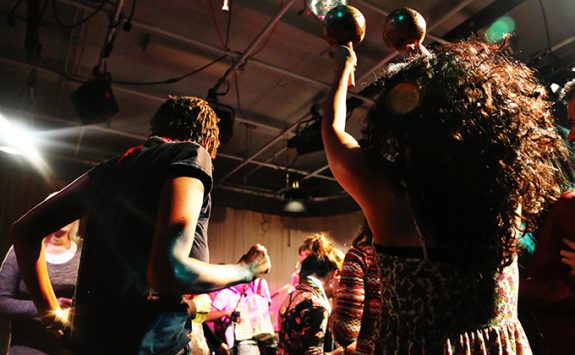
This post about teaching improvisation skills to your piano students using salsa was written by Rachel Palm. Rachel grew up in the jungles of Brazil listening to an eclectic and fun mix of music. She currently teaches piano in Greenville, South Carolina and blogs at palmpianostudio.wordpress.com. When she isn’t teaching or playing piano, she enjoys long hikes, large cups of tea, and tall stacks of books.
When I first heard Salsa music at a local dance event in Brazil, it enthralled me. Having grown up dancing to its infectious rhythm and exuberant melodies, I began looking for salsa recordings and then salsa sheet music to help me make similar sounds on the piano. Now, I want to help my students experience some of that as well – and you can, too.

Modern salsa music comes from Cuba, blending together several rich musical heritages: Cuban, Spanish, Haitian, African and French. Many people from these heritages immigrated to Cuba hoping to build a new life. Sharing the island of Cuba, they put traditional music and dance together to create what we now know today as salsa music.
The word salsa means “sauce”. When you hear good salsa music, it’s the result of immigrants bringing together unique styles and rhythms, cooking up a tasty musical sauce.

Eventually, in the early 1900s, many Cuban musicians left for America and settled in Miami or New York, bringing their wonderful salsa music with them. When they performed at dances, bands would yell out, “Salsa!” to encourage the dancers to move more excitedly and flamboyantly. It was a way of saying, “Spice it up, everybody!”
Today, we’re going to help our piano students spice up their improvisation using salsa. Let’s SALSA!
A Fun Salsa Music Sample
In salsa music, it’s really important to feel the big beats in duple time or of 1 and 3 in 4/4 time. I often get my students to move and chant to understand rhythm in their lessons, and salsa rhythms are great to experiment with.
Listening to a recording like the one below, I like to stand up with my students and move our feet to the big beats. Try it – see if you can keep a steady rhythm.
I also ask my students to listen to how the piano is repeating the same improvisation pattern over and over. You can really hear piano salsa patterns during the introduction and verses of salsa music.
If improvisation scares the heck out of you, this blog post will help you take those first (wobbly) steps.
The Salsa Improv Challenge
Salsa music can be complicated, and I want to help my students to enjoy it even if they can’t play some of the more complex salsa patterns yet. So I created the Salsa Improv Challenge.
In salsa music, the piano acts as both a harmonic and percussive instrument. You have to be very good at playing a steady salsa rhythm before you can add chords.
So for the Salsa Improvisation Challenge, my piano students first learn several salsa rhythms. They clap the rhythms, tap them with their feet, and then play them using one or two notes on the piano.
Once they’ve mastered the rhythms, they can then try adding salsa chords and patterns to those rhythms. For fun, I’ve added a few levels to the challenge so students can describe the complexity of their improv sessions.
Levels for Salsa Improv Challenge
- Mild: Students use 1-2 salsa ideas in their improv
- Medium: Students use 3-4 salsa ideas in their improv
- Hot: Students use 5-6 salsa ideas in their improv
It’s a lot of fun to ask a student what kind of salsa they’re going to play for me. Sometimes, I also turn around while a student plays and see if I can guess what level it was: mild, medium, or hot.
Even if a student is only doing the rhythm part of the challenge, they still want to work up to the ‘Hot’ level. The fun thing about separating rhythm from pitch is that this challenge can go on for several lessons, and can frequently make reappearances.
For the Salsa Improv Challenge, choose from the rhythms and related melodies I’ve shared below to create your own little melting pot of tasty musical sauce. Students can add these rhythms to their improvisations over the course of several weeks in order to work their way up to the ‘Hot’ salsa level.
Nicola has a hub page all about Teaching Creative Skills. Head over there for more improvisation fun!
Rhythm Patterns for Students
Here are some examples of common salsa rhythms:
For these rhythms, try:
- Tapping with hands
- Beating on a drum
- Tapping with feet
- Playing on one or two keys of the piano
Chord Patterns for Students
Once my students have a few rhythm patterns down, I have them try adding notes from the chord patterns below.
In salsa music, the piano will often play a montuno.
A montuno is a chord-based rhythmic pattern of notes which can be riffed on as a solo improvisation, or repeated while other instruments and vocalists improvise over it. These montunos can be very complicated, so I chose to simplify the most popular salsa montunos in the riffs above so all my students could practise them.
How spicy did you get??
Leave a note letting us know which rhythm patterns and melodies you and your students tried, and what level of salsa you reached. I hope it was HOT! 🌶️









I can’t wait to play with this! I’m on Spring Break so I will have plenty of time to get it ready!
Really pleased to hear this Tanya, enjoy!
This is awesome. I have a young adult student who started lessons with me just three months ago, and when he signed up, he specifically asked if he could learn salsa music. I’m going to prepare a handout based on all of this and go over it with him at his next lesson. He’ll love it, as will I!
That’s really great to hear about your young mature student specifically requesting salsa-themed learning! Many thanks and enjoy, Celeste-tina!